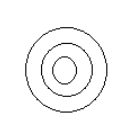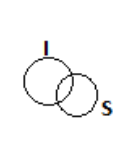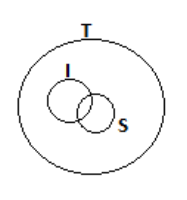
If T = Set of all triangles in a plane, I = Set of all isosceles triangles, and S = Set of all acute triangles. Which of the following diagrams describes the above sets best?
A.

B.

C.

D.





Answer
576.6k+ views
Hint: If all the triangles from set A follow the property of triangles in set B, then set A is a subset of set B and is denoted by a small circle present in a bigger circle, if some of the triangles from set A follow the property of triangles in set B, relation between them is shown by two intersecting circles else, the two circles are separate if none of the property is satisfied. Use this concept, after knowing the definitions and property of the mentioned triangles.
Complete step-by-step answer:
T = Set of all triangles in a plane
I = Set of all isosceles triangles
S = Set of all acute triangles
The set T is the universal set of all triangles which consists of all the types of triangles- right angles, acute angled, obtuse angled, isosceles, equilateral, scalene etc.
Set I contains all the isosceles triangles.
An isosceles triangle has two sides equal in length in therefore two of its corresponding angles are also equal. Now depending on the measure of all the angles an isosceles triangle can be acute, obtuse or right angled.
Set S has all the acute angled triangles.
Acute angled triangle implies that all the angles present are acute and according to the length of the sides, these types of triangles can be scalene, isosceles and equilateral.
From the above information, we come to the conclusion that an isosceles triangle can be an acute angled triangle.
Also, an acute angled triangle can be isosceles.
So, we can say that some isosceles triangles are acute angled and some acute angled triangles are isosceles.
This according to the concept of Venn diagrams will be shown by two intersecting circles having 2 points of intersection.

Also, whether it is an isosceles triangle or an acute angled triangle both will come in the universal set of all triangles. So, this will be depicted by the containment of the 2 circles in a big circle of set T.

Hence, the correct option is B.
Note: The fact that an isosceles triangle can be obtuse angled as well relies on the basis that, the sum of all the angles of a triangle is 180 degrees, therefore, there is a scope that an angle greater than 90 degrees and two very small equal angles can form an isosceles triangle. For a triangle to be acute angled, all the angles must be less than 90 degrees.
Complete step-by-step answer:
T = Set of all triangles in a plane
I = Set of all isosceles triangles
S = Set of all acute triangles
The set T is the universal set of all triangles which consists of all the types of triangles- right angles, acute angled, obtuse angled, isosceles, equilateral, scalene etc.
Set I contains all the isosceles triangles.
An isosceles triangle has two sides equal in length in therefore two of its corresponding angles are also equal. Now depending on the measure of all the angles an isosceles triangle can be acute, obtuse or right angled.
Set S has all the acute angled triangles.
Acute angled triangle implies that all the angles present are acute and according to the length of the sides, these types of triangles can be scalene, isosceles and equilateral.
From the above information, we come to the conclusion that an isosceles triangle can be an acute angled triangle.
Also, an acute angled triangle can be isosceles.
So, we can say that some isosceles triangles are acute angled and some acute angled triangles are isosceles.
This according to the concept of Venn diagrams will be shown by two intersecting circles having 2 points of intersection.

Also, whether it is an isosceles triangle or an acute angled triangle both will come in the universal set of all triangles. So, this will be depicted by the containment of the 2 circles in a big circle of set T.

Hence, the correct option is B.
Note: The fact that an isosceles triangle can be obtuse angled as well relies on the basis that, the sum of all the angles of a triangle is 180 degrees, therefore, there is a scope that an angle greater than 90 degrees and two very small equal angles can form an isosceles triangle. For a triangle to be acute angled, all the angles must be less than 90 degrees.
Recently Updated Pages
Master Class 12 Economics: Engaging Questions & Answers for Success

Master Class 12 Maths: Engaging Questions & Answers for Success

Master Class 12 Biology: Engaging Questions & Answers for Success

Master Class 12 Physics: Engaging Questions & Answers for Success

Master Class 8 Maths: Engaging Questions & Answers for Success

Class 8 Question and Answer - Your Ultimate Solutions Guide

Trending doubts
What is meant by exothermic and endothermic reactions class 11 chemistry CBSE

Which animal has three hearts class 11 biology CBSE

10 examples of friction in our daily life

One Metric ton is equal to kg A 10000 B 1000 C 100 class 11 physics CBSE

1 Quintal is equal to a 110 kg b 10 kg c 100kg d 1000 class 11 physics CBSE

Difference Between Prokaryotic Cells and Eukaryotic Cells




